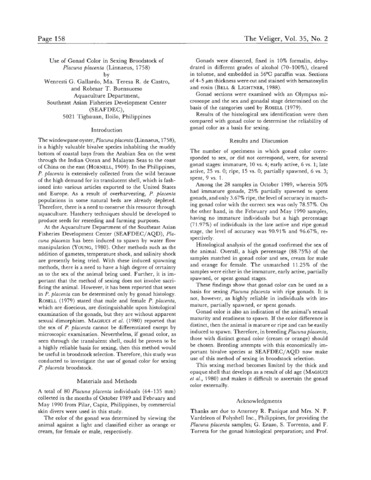Use of gonad color in sexing broodstock of Placuna placenta (Linnaeus, 1758)

ရှာဖွေ/ဖွင့်ပါ။
ရက်စွဲ
1992Page views
623
Share
စိတ္တဇ
The window pane oyster, Placuna placenta (Linnaeus, 1758), is a highly valuable bivalve species inhabiting the muddy bottom of coastal bays from the Arabian Sea on the west through the Indian Ocean and Malayan Seas to the coast of China on the east (Hornell, 1909). In the Philippines, P. placenta is extensively collected from the wild because of the high demand for its translucent shell, which is fashioned into various articles exported to the United States and Europe. As a result of overharvesting, P. placenta population in some natural beds are already depleted. Therefore, there is a need to conserve this resource through aquaculture. Hatchery techniques should be developed to produce seeds for reseeding and farming purposes.
At the Aquaculture Department of the Southeast Asian Fisheries Development Center (SEAFDEC/AQD), Placuna placenta has been induced to spawn by water flow manipulation (Young, 1980). Other methods such as the addition of gametes, temperature shock, and salinity shock are presently being tried. With these induced spawning methods, there is a need to have a high degree of certainly as to the sex of the animal being used. Further, it is important that the method of sexing does not involve sacrificing the animal. However, it has been reported that sexes in P. placenta can be determined only by gonad histology. Rosell (1979) stated that male and the female P. placenta, which are dioecious, are distinguishable upon histological examination of the gonads, but they are without apparent sexual dimorphism. Macsuci et al. (1980) reported that the sex of P. placenta cannot be differentiated except by microscopic examination. Nevertheless, if gonad color, as seen through the translucent shell, could be proven to be a highly reliable basis for sexing, then this method would be useful in broodstock selection. Therefore, this study was conducted to investigate the use of gonad color for sexing P. placenta broodstock.
Suggested Citation
Gallardo, W. G., de Castro, M. T. R., & Buensuceso, R. T. (1992). Use of gonad color in sexing broodstock of Placuna placenta (Linnaeus, 1758). Veliger , 35(2), 158-159. http://hdl.handle.net/10862/1373
ဘာသာရပ်
စုစည်းမှုများ စုစည်းမှုများ
- AQD Journal Articles [1249]
